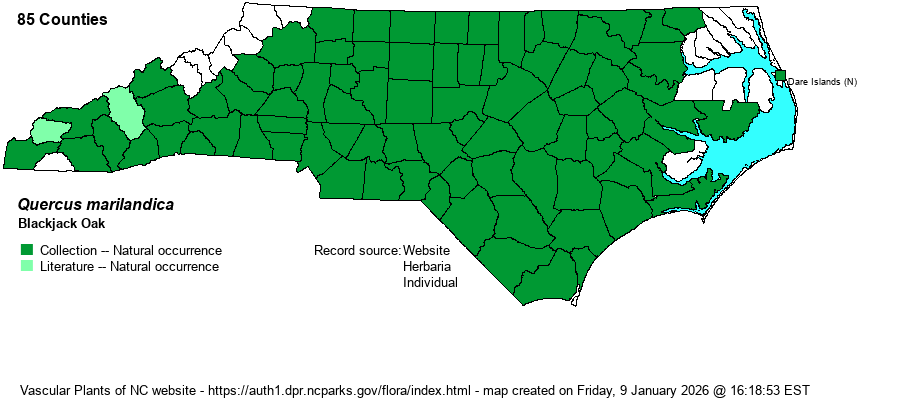| Author | Muenchhausen | |
| Distribution | Occurs nearly throughout the Coastal Plain and Piedmont, though scarce or absent in a few far northeastern counties (such as north of Albemarle Sound). Scarce in the Mountains, where limited to low elevations in the southern counties; apparently no records north of Buncombe and Madison counties.
This is a widespread species of the Southeast and southern Midwest states. It ranges north to NY (Long Island) and southeastern NE, and south only to northern FL and most of eastern TX. It is scarce in the Appalachians and north of the Ohio River (except in IL).
| |
| Abundance | Reasonably common in the southern half of the Coastal Plain, especially in sandhills habitats. Elsewhere in the Coastal Plain and Piedmont, it is infrequent to fairly common, but seldom is a common tree anywhere in these regions, despite being found in nearly all counties. Rare to uncommon in most of the southern Mountains, though perhaps more numerous in Cherokee County. | |
| Habitat | A great variety of upland, dry soils. In the Coastal Plain it favors dry soils with more clay and less deep sand, under Longleaf (Pinus palustris) or now Loblolly (P. taeda) pines. In the Piedmont it is typically found in thin soils over shallow bedrock, or in somewhat sandy soil; these soils can often be circumneutral and “glady”, such as with Eastern Red Cedar (Juniperus virginiana). In the mountains it is found mainly on dry south-facing slopes or other thin or rocky soils, often under pines. Thus, the presence of this species in the Piedmont (and to a lesser extent in the mountains and Coastal Plain), especially if growing in some numbers, may symbolize a rare habitat or natural community that warrants a more detailed survey. |
| Phenology | Flowers in April and May; fruits from September to November of the second year (after flowering). | |
| Identification | This is a familiar small to rarely medium deciduous tree, growing mostly to about 50 feet tall, with rather thick limbs. The bark typically shows rectangular black plates. This tree is noted for its quite thick and shiny leaves (on the upper surface); however, leaf shape is somewhat variable. Typical leaves can easily be identified by the bell shape -– narrowed to the base, but widely flared toward the apex, often with single shallow lobes on each side near the tip. Though the lobes have small bristle tips, identifying them as a member of the “red oak” group with acorns maturing in the second year, at a glance the leaves appear to have rounded margins without bristle tips. Note that this species can often hybridize, and thus you may often run into oaks with top-shaped leaves but with larger lobes; however, a good Blackjack Oak usually is rusty or tawny-colored on the lower leaf surface and has a very thick leaf. | |
| Taxonomic Comments | None, though Weakley (2018) lists the taxon as occurring in NC as a variety -– the nominate Q. marilandica var. marilandica.
| |
| Other Common Name(s) | None. However, many country people refer to some or all “scrub oaks” as Blackjack Oak. Thus, a biologist should take this name with a grain of salt when talking with non-botanists until he or she can verify the actual species being discussed! | |
| State Rank | S5 | |
| Global Rank | G5 | |
| State Status | | |
| US Status | | |
| USACE-agcp | | |
| USACE-emp | | |

